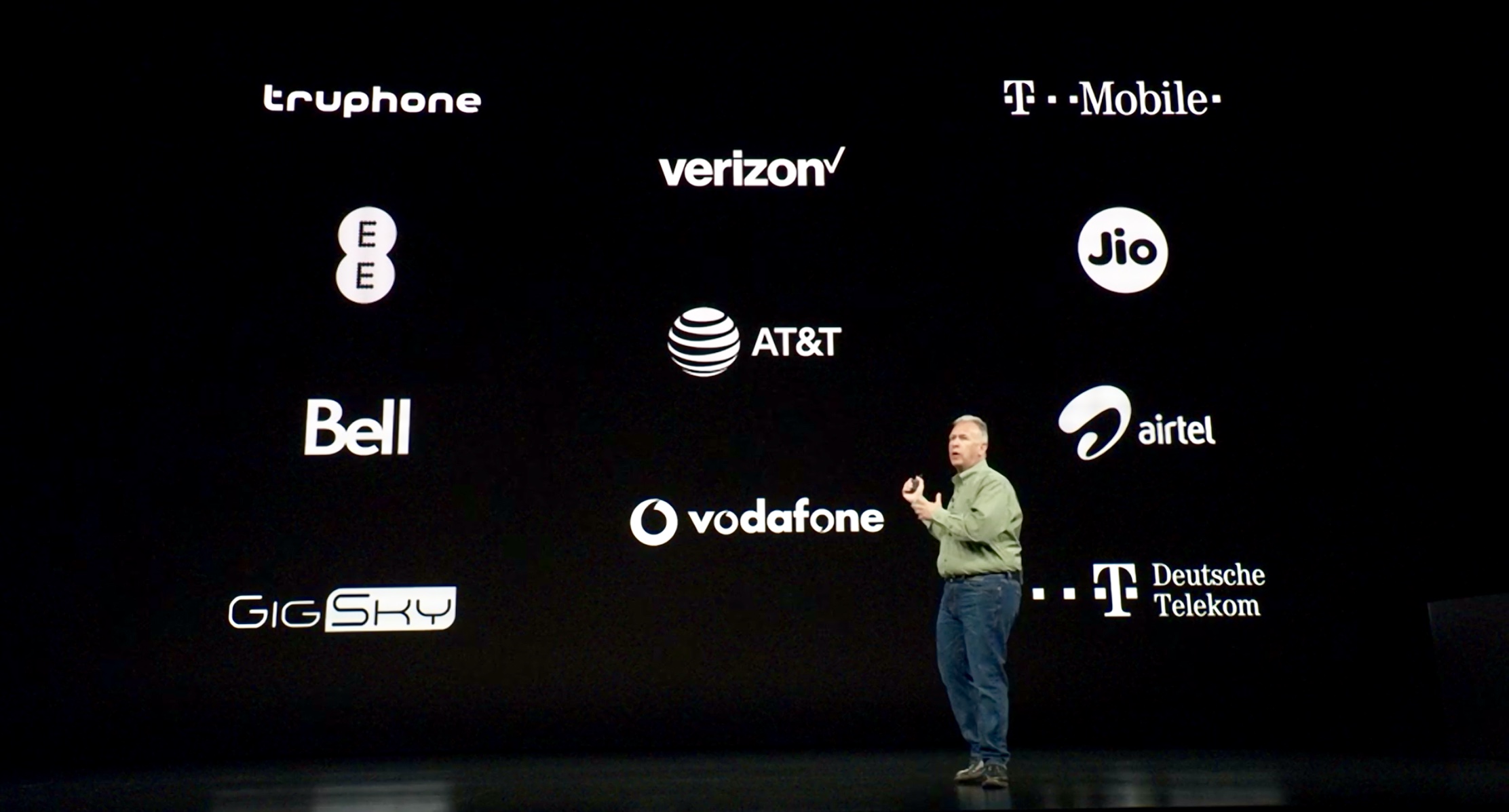On Tuesday, September 12th, at the Steve Jobs Theater on Apple’s new HQ in Cupertino, Phil Schiller announced that the new iPhone XS series of phones would come with an eSIM to a smattering of applause. While eSIM’s have been used in the Samsung Gear 2 3G, Google Pixel 2, iPad Pro (Apple SIM) and the Series 3 Apple Watch, the iPhone has the potential to accelerate the broader eSIM adoption among carriers across the globe laying the foundation for the next big thing in Internet of Things (IoT) endpoint privacy and security.
The Killer App for eSIM Adoption – The iPhone
What is eSIM? eSIM allows for re-programmable SIM functions that are embedded to a carrier-connected device such as the Apple Watch 3 (LTE version), smartphones and a wide variety of industrial and growing range of consumer device categories. Traditionally, SIM cards needed to be physically replaced, which required that you go to the carrier to get a card to provision your device on their network. With eSIMs, consumers can easily switch between carriers, service providers, or between identities across geographies.

Could the iPhone XS drive carriers to begin taking eSIM adoption seriously? I think so. Apple is known as a transformative force in the technology industry that consistently defines the leading edge of the technology market while driving mainstream adoption of emerging technologies whether it is advanced semiconductor designs that incorporate dedicated AI processing, emerging biometrics such as Face ID and Touch ID, or the advanced sensor fusion capabilities that utilize the iPhone’s True Depth camera to enable a wide range of new and innovative selfie applications. Just look at how quickly the infamous “notch” has been adopted by smartphone manufacturers.
Upgrade Programs, Replacement/Refurb Cycles Put Apple in The Driver Seat of eSIM Adoption
As Phil Schiller announced, the new Apple iPhone XS series will have dual SIM capabilities as well as eSIM (embedded Subscriber Identity Module) for countries and a growing number of carriers, including Sprint, that will support Apple’s eSIM. Dual SIM allows for multi-carrier support which is good for world travelers, or within the same country to have two numbers associated with the device, e.g. a work number and a personal number.

Let’s face it, the genie is out of the bottle. Business travelers will drive an enterprise demand for eSIM support for smartphones to reduce overall service spending as Apple’s iPhone’s popularize the eSIM globally. Local carriers and MVNOs supporting the business traveler, especially in continental markets such as the EU or APAC, can differentiate themselves from slower eSIM adopters by providing convenient, flexible and cost effective provisioning of voice and data services. The competitive dynamic is set for laggers to lose.
The other Apple factor that makes the eSIM announcement for the iPhone even more compelling is the massive reburb market for iOS devices that are typically handed down or traded-in over a 5 to 6 year period given that iOS 12 will support the six year old iPhone 5s. Furthermore, we can expect an increasing frequency of device transfers that can be facilitated and simplified by eSIM support given the growing and lucrative trend of Devices as a Service exemplified by the Apple iPhone Upgrade Program and similar programs offered by Verizon and AT&T.
The Consumerization of The Internet of Things Continues with Privacy First
Though eSIMs have been used for simple Internet of Things (IoT) devices to support M2M communications, eSIMs will become important in securing the fast-growing categories of consumer IoT. Beyond the flexibility of multiple operators and multiple phone numbers, consumers can now have multiple profiles or personas with different identities, applications and service provisions associated with a device, which will bring about the shared device models and related services that could present new opportunities for carriers and device OEMs.
Currently device portability like Wireless Local Number Portability allows consumers to swap carriers and keep their number and user profiles, but this is mostly done for smartphones, and less so for IoT devices. Nowadays many IoT devices like the Apple Watch have healthcare sensors with personal information that needs to be securely maintained in the new Privacy First world brought on by GDPR.
As consumers swap carriers but keep their devices, their personal information needs to be securely maintained, along with the operator services, such as user authentication, as well as encryption certificate support, and policy controls for contextually-aware services. Imagine an IoT sensor device that is shared between friends and family. eSIM with persona-based controls can allow for this capability that can enable new categories of shared assets and sharing services.
Get Ready for New Agile, Privacy First, Secure IoT Services!
eSIM will be a critical enabler of improved, integrated administration and secure management of new and refurbished connected devices in the 5G world where devices may need to cross networks, network technologies and service providers. Here are some key impacts that I see eSIM will have on the future of IoT.
- eSIM IoT will help us share – With holistic security integrated and privacy maintained within all IoT devices and across user identities enabling new shared device and asset models. eSIM can allow for persona-based re-provisioning of the same device across multiple users and carriers.
- Continuous, persona-driven experiences – There has been a dramatic shift in the way we interact with customers with Digital Transformation. Experience can be delivered with continuity across devices: e-Kiosks, Point of Sales systems, mobile devices, interactive digital signage, which all now can be seamlessly powered with secure reprogrammable contextual information. Imagine the TV is IoT-enabled with eSIM-based persona management with content preferences dynamically loaded as you walk into your home and turn on your TV or with default child-preferences when your child is watching TV during the day.
- Democratized operator connectivity via eSIM – Imagine not manually inserting and provisioning and software updating all of your IoT devices as you switch carriers, just for a trip, or just for a new job, or just for a short time, including devices embedded in vehicles or in HVAC controllers, video surveillance, and appliances. This is virtually impossible with legacy hardware-based SIM cards. Enter eSIM-based auto provisioning and IoT connection management across carriers, for short pay-as-you-go services.
Implication for Business Leaders
Carriers need to consider a world where customer lock-in can no longer depend on the wall of inconvenience that is the traditional SIM card. Carriers need to find new services and business models for retaining customers such as Device as a Service models as in AT&T and Verizon’s upgrade programs.
Enterprises should work with their carrier partners to drive the economies of convenience that eSIM provides to their endpoint strategies and consider the benefits that can be realized in securing BYOD devices on the enterprise network.
Technology vendors should explore developing solutions for their carrier customers that foster the proactive management of identity and provisioning/de-provisioning of services and data using eSIM technologies.
Device manufacturers and IT service providers should explore the connectivity and security possibilities that eSIM presents in enabling new shared device features and services that can benefit from enhanced identity and privacy management.
If you are interested in getting additional insight on the topic of eSIM and the emerging technologies and platforms for managing the identity and security of consumer, enterprise and IoT endpoint devices, contact us for an inquiry session with our neXt Curve analysts and consultants.
by Akshay Sharma
Research & Advisory Fellow, neXt Curve
September 14, 2018
© 2018 neXt Curve. All rights reserved.
2 comments